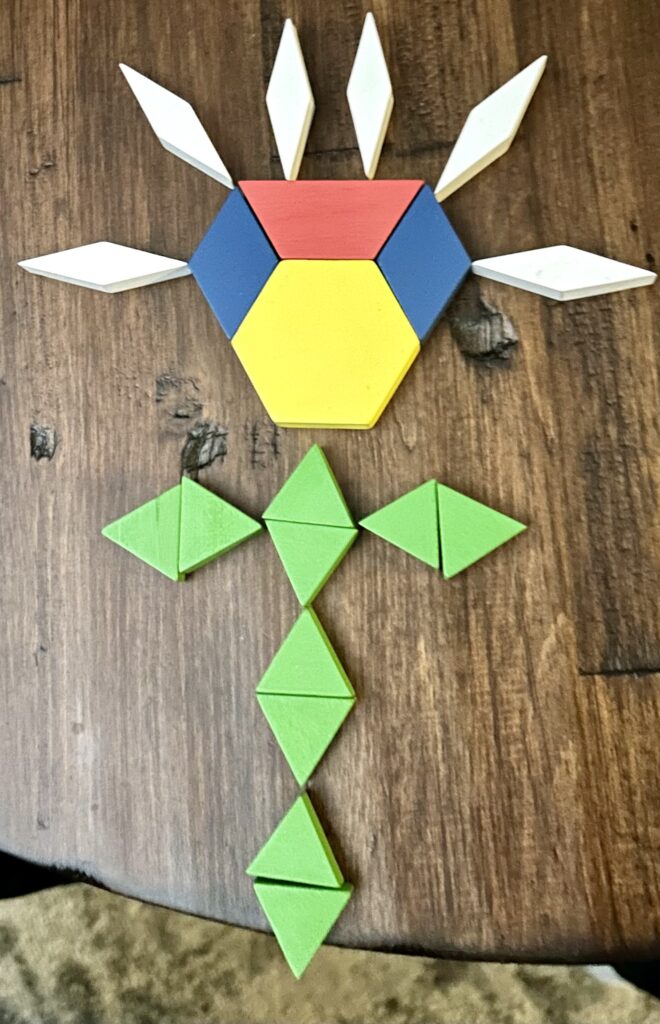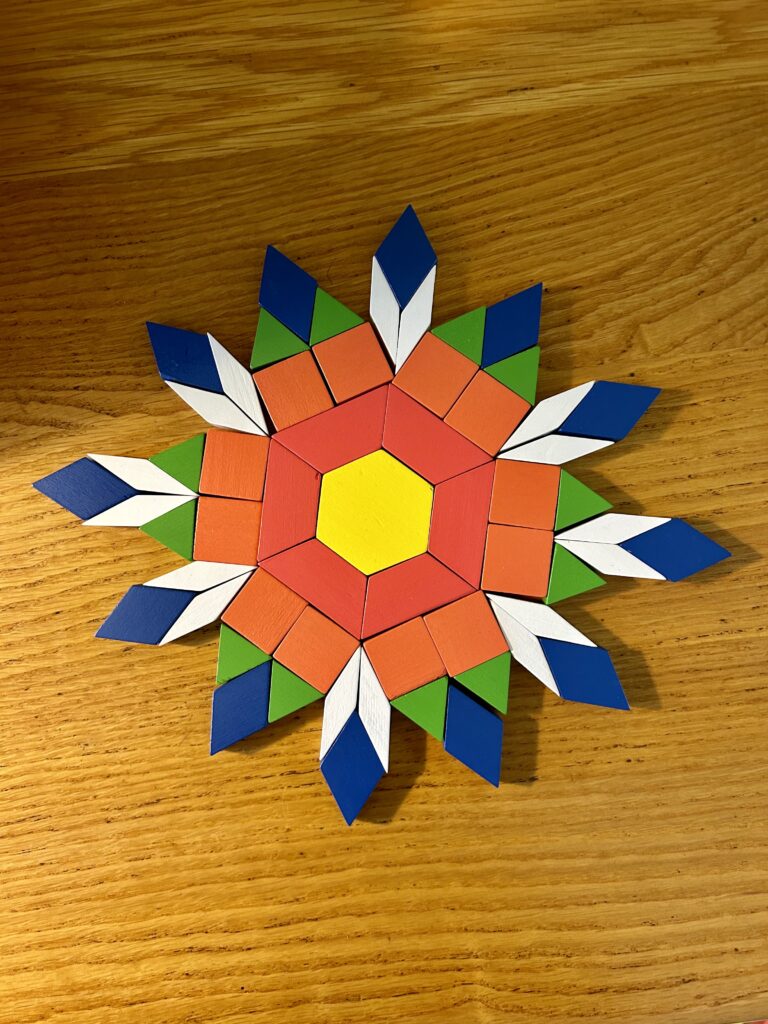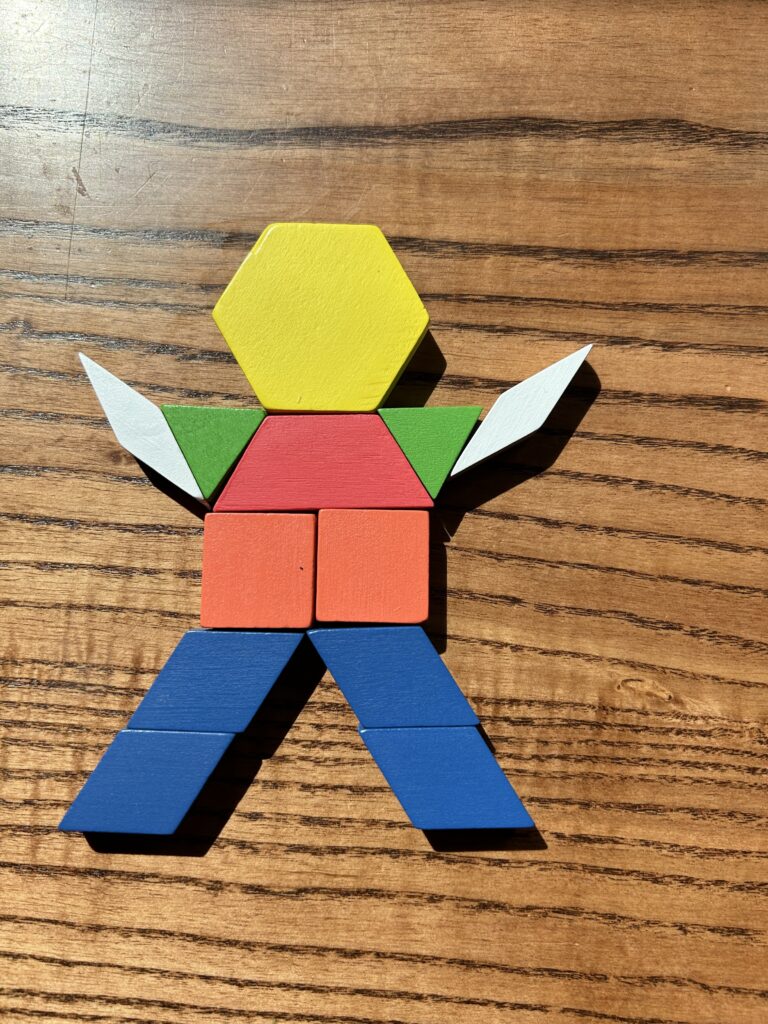STEM Play With Pattern Blocks

“Hey, that’s cool. I like your guy!” says four-year-old Jaheem, peering over Michelea’s shoulder as she plays with her pattern blocks.
“It’s not a guy; it’s a flower!” Michelea replies, tilting her head to try to see the “guy” that Jaheem is referring to.
“That’s the stem and the leaves,” she explains, pointing to the green triangles. “And these blocks at the top are the flower.”
Then James weighs in, laughing as he sits down next to Michelea to join in the block play. “I thought it was a guy too—and you forgot to make the other leg!”
“Did you think these were arms?” Michelea asks, giggling. “They aren’t arms; they’re leaves!”
The friends continue to banter good-naturedly as they design with their pattern blocks. The beauty of block play is that it’s hands-on—which facilitates deeper learning and creates a more enjoyable and memorable experience.
We have many different types of blocks in our early childhood classroom, but the pattern blocks—introduced by the Education Development Center in the 1960s to help children develop the spatial reasoning skills they need to master math—have been a part of our play rotation for the past few weeks.
A set of pattern blocks typically consists of six different shapes in six different colors: a yellow hexagon, a red trapezoid, a green equilateral triangle, a blue rhombus, an orange square, and a tan or white thin rhombus. Except for the trapezoid, the lengths of the sides of each shape are the same, which makes it easy for children to fit the pieces together when creating pictures and designs.
Pattern-block play builds inventive and imaginative thinking. These blocks seem to unlock a particular kind of creativity that isn’t always evident in other forms of block play.
This morning, Jaheem, Michelea and James seem to be creating stories with their pattern blocks while collaborating and mentoring each other in a relaxed and playful way.
 “Look! Michelea tells James, pointing at her latest pattern-block creation. “This is you walking your dog in the sunshine. It took me a long time because I had to figure out how to make the legs. I had them turned in the wrong direction!”
“Look! Michelea tells James, pointing at her latest pattern-block creation. “This is you walking your dog in the sunshine. It took me a long time because I had to figure out how to make the legs. I had them turned in the wrong direction!”
As children discover that they can rotate, flip and rearrange shapes in different ways, they become increasingly aware of two-dimensional shapes. Block play also promotes fine motor skill development as children manipulate the blocks to create their designs.
I watch as Jaheem, James and Michela learn how to measure heights, lengths and areas. Geometric shapes are a kindergarten common core standard, and when children engage in hands-on play with shapes, the learning becomes deeper, more intentional and more relevant.
Geometry is the area of mathematics that involves shape, size, position, direction, and movement. In early childhood education, geometric skills include identifying and comparing shapes, differentiating between shapes, and creating shapes.

The research backing up the importance of spatial skills in early learning is extensive and well-documented:
- A 2009 Vanderbilt University review in the Journal of Educational Psychology looked at over 50 years of longitudinal research on spatial ability and concluded that “spatial ability plays a critical role in developing expertise in STEM.”
- In its Learning to Think Spatially consensus study report, the National Research Council underscored the importance of spatial skills, stating that “underpinning success in both mathematics and science is the capacity to think spatially.”
- A 2017 study from the University of Toronto looked at a spatial-skills intervention implemented in grades K-2. Students were presented with activities that targeted spatial skills, such as finding lines of symmetry, proportional reasoning (the number of tiles needed to fill a space), composition, and visualization. The study found that participating students showed improvement in spatial language, visual-spatial reasoning, 2D mental rotation, and symbolic number comparison.

During today’s pattern-block play session, the three preschoolers are actively exploring combinations of shapes in their constructive play. I watch as they discover that they can combine two squares to make a rectangle and investigate what happens when they turn a shape upside down. (It’s still the same shape even if it looks different!)
Research shows that young children’s spatial skills, rather than their numerical abilities, predict their overall mathematics achievement: The key skills are visualizing what shapes will look like when they are combined or rotated (Young et al., 2018). Working with shapes and spaces may provide a more accessible route to math proficiency for some children than focusing only on numbers.
Pattern-block play also promotes creativity and problem-solving—with no rules or guidelines to stop the flow. Children have the freedom to create their own designs and structures without having to worry about “getting it right.”
So dig out those pattern blocks and watch the spatial awareness blossom and the creativity flow!
This is cool. Allowing kids to create their own patterns and designs…gives a great view of how they see everyday objects.
I work in an infant classroom. The children have soft, patterned, shaped blocks that they usually mouthe during play times. They enjoy this activity.
I work in the infant room and we are now getting into patterns.
so are we, were using our fat squishy blocks, they love the colors
Having taught kindergarten for many years, pattern blocks are a staple in my classroom. We have always used the month of September for students to freely explore these materials every morning upon arrival and again at Free Choice Time before we use them for more formal instructional purposes. Pattern Blocks provide valuable learning experiences for the young child that cannot be replicated through a boxed or online curriculum.
I work in a daycare, all our classes have small and big foam building blocks. the kids love to try and make the tallest wall they can. We also have big and little dominos to play with that they can stack or make patterns with or just find matches with the number of dots on the domino.
i work in a child carecenter. At times ,I may find myself in any given room with any given group. My go to project is pattern building. I can always find something to use to make a pattern. Then the children do it. Some are so interesting.
I like Marianne’s idea about using a whole month to explore. The children in my classroom usually use pattern blocks to make the same shape as their friend. from reading the article I think I will spend more instructional time on these blocks.
I run an in-home daycare. The kids, even the older ones, enjoy building with the different blocks provided. Fun to watch their little minds at work!
Love this! I work with 2 year old and we have just cubed blocks. I will definitely request different shaped blocks to allow students to use their imagination!
This is a fun activity. Use of cards with pre-printed patterns and free choice help all the learners at their level
I incredible how they create with blocks of different shapes
It is awesome the way the shapes take form and yet it teaches them. Keeps them engaged.
Love this! These blocks are fantastic in the classroom.
Pattern blocks are such a great classroom tool! The children get so creative with them and we have discussions of what we see in everyone’s creations.
It’s good that the kids are using different shapes and colors to make a image
Non-standard measurement
In our center, we have several sizes of blocks. Each room has different sizes. Sometimes, when enrollment is low for the day, we might have a challenge between rooms, measuring. Each room is given the same item to measure. At the end, we see how many small blocks were needed, how many medium sized blocks and how many large sized blocks.
This is a great way for kids to brainstorm and also try to solve things by themselves while also matching
The children enjoy block play time. I love watching their lil minds work
I think these blocks could be used for simple patterns as well.
We have been using patterns , and it’s so much fun. Their creativity is beyond what one expects ! We see something different , and they do a whole different image or pattern !
I agree with you, Sandra! It is SO much fun and such a great foundation for future geometry! The children never get tired or bored with our pattern blocks! It makes the math learning standards so easy to check off! Thanks for sharing!